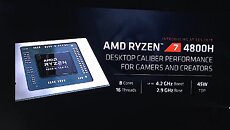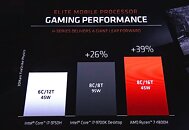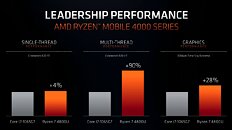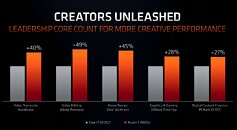Monday, January 6th 2020

AMD Announces Ryzen 4000 Mobile Processors: 4800U and 4800H
AMD today announced its Ryzen 4000-series mobile processors designed to compete with Intel's fastest, across both its 10th gen "Ice Lake" and "Comet Lake" mobile processors lines. At the heart of these processors is the 7 nm "Renoir" silicon, which doubles the CPU core count over the previous generation "Picasso," and improves IPC (single-thread performance) by a double-digit percentage. "Renoir" combines a CPU with 8 cores based on the "Zen 2" microarchitecture, with an iGPU that has the number-crunching machinery of "Vega," but with display- and multimedia-engines of "Navi." It is a monolithic piece of silicon with a dual-channel IMC that supports not just conventional DDR4 memory, but also fast LPDDR4X.
There are two distinct classes of Ryzen 4000 Mobile: U and H. The Ryzen 7 4800U, with its 15 W TDP, targets ultra-portable notebooks, and goes head-on against Intel's Core i7 "Ice Lake-U" processors, winning on the CPU front with its high core-count and IPC. The Ryzen 7 4800H, on the other hand, taps into the 45 W TDP headroom to dial up CPU and iGPU clock-speeds significantly, offering CPU performance that beats the desktop Core i7-9700K. It also introduces SmartShift, an iGPU + dGPU virtualization technology that lets your notebook dynamically switch between the two based on graphics load.
There are two distinct classes of Ryzen 4000 Mobile: U and H. The Ryzen 7 4800U, with its 15 W TDP, targets ultra-portable notebooks, and goes head-on against Intel's Core i7 "Ice Lake-U" processors, winning on the CPU front with its high core-count and IPC. The Ryzen 7 4800H, on the other hand, taps into the 45 W TDP headroom to dial up CPU and iGPU clock-speeds significantly, offering CPU performance that beats the desktop Core i7-9700K. It also introduces SmartShift, an iGPU + dGPU virtualization technology that lets your notebook dynamically switch between the two based on graphics load.





53 Comments on AMD Announces Ryzen 4000 Mobile Processors: 4800U and 4800H
Binning for efficiency is most definitely a reality, but it can't work miracles such as lowering power draw by 66% for the same performance. Which is why low-power chips are good for bursty workloads (as they are allowed to (often dramatically) exceed their power budgets for limited time spans), but slower than their higher power counterparts in anything continuous.
As I mentioned before, there's plenty of documentation that Intel's 15W low-power chips consume 45-55W (or even more!) in their short turbo windows before scaling down to much lower clock speeds for a sustained 15W power consumption. That's how modern CPUs work, how they have such high boost specifications, and why understanding the difference between boost clock and base clock is crucial to understanding the differences between these products.
The binning at price points you are describing also happens, but mostly within a performance category (i.e. a 15W i7 generally costs the OEM more than a 15W i5 or i3), but chip prices across categories aren't easily comparable. Why? Because you can't outright say that one is "better" than the other. A 45W Ryzen 7 and a 15W Ryzen 7 are both high-bin chips, just different high bins (the 15W is likely binned for overall low voltage, low leakage current and hitting a good point on its DVFS (Dynamic Voltage Frequency Scaling) curve around 15W of package power, while the 45W is likely binned for hitting a good point on its DVFS curve at 45W, better efficiency at high clocks, and better clock scaling overall. Both are high bins, but different high bins, and as such both can realistically command a premium price.
You CAN have different TDP chips from the same manufacturer, built using the same architecture and process with the same perf, but different power consumption.
We got into this part of the discussion because @ratirt started insisting that the 4800H wouldn't outperform the 4800U because they have the same max boost spec, which again sprang from the failure to accept that saving on iGPU power in a 45W chip would allow for higher CPU power and thus performance. This has been a long and winding road from the seemingly simple task of trying to explain why there isn't a fully enabled iGPU on a 45W APU.
Edit: damn autocorrect.